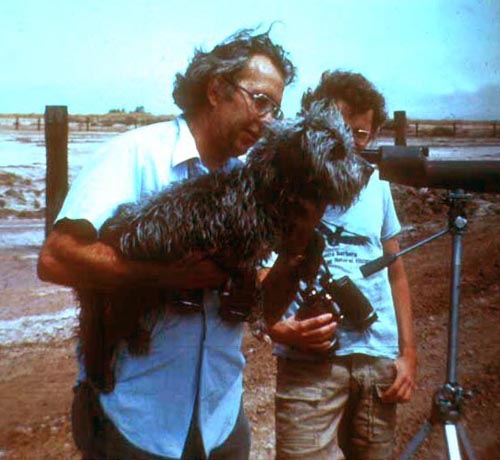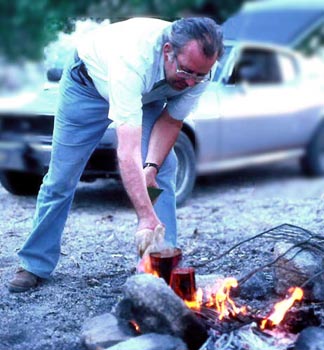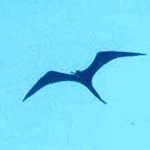 In
the highly recommended American Birds article, various colleagues
and protégés described this influence: In
the highly recommended American Birds article, various colleagues
and protégés described this influence:
-
"That Guy McCaskie revolutionized California birding is a cliché
and an understatement," wrote Kimball Garrett. "He taught us that birding
can be surgical and rigorous (yet always fun), that there is rhyme and
reason to the occurrence of vagrants, and that a birder's true legacy is
that which is in print."
-
"Guy's arrival in California in the late 1950s was to cause not only a
CHANGE in North American Ornithology, but a RENAISSANCE. Birdwatching was
about to have its definition remodeled and its confining protocol burst
open," said Rich Stallcup. "It was fun, too. There were endless conversations
on bird-related topics during all-night drives to tomorrow's birding destination,
there were outrageous adventures along The Road and there was the
thrill of pioneering many areas that would become routine stops to thousands
of birders a decade later."
-
"In the early years, Guy documented the occurrence of vagrants with voucher
specimens, but through the years this practice has been replaced by taking
detailed field notes," wrote Jon Dunn. "Guy and others created the California
Bird Records Committee. It was designed primarily to evaluate sight records
of vagrants... I often find it ironic that since leaving Great Britain
in 1957, Guy has never returned ... [and] Guy's accent became thoroughly
Americanized by the time I met him.... Despite growing older, Guy is just
as active as he was 30 years ago driving all over the state at all hours
and from what I can detect none of his enthusiasm for birding has diminished."
-
Richard Webster agreed: "The excitement of finding what is out there is
something that Guy still has. I drag myself to the 3 a.m. meeting point
for the drive to the Salton Sea and find myself in the presence of a bright-eyed
McCaskie, raring to make what may his 400th early morning foray to brave
the heat, mud, and rotting fish. Perhaps he will find his ninth species
of tubenose for the Salton Sea. Perhaps he won't. Either way he will enjoy
it, and be back next weekend...."
-
In an unpublished essay written after reading the American Birds
piece, Jon Winter wrote: "[Guy] was always prepared to see and expect the
unusual and was aware of what to look for... Guy was always looking...
I recall reading in Audubon Field Notes in years past about all the wonderful
birds he would see at the Salton Sea. What I did not know at the time was
that for every trip he made to the Salton Sea, or some such place in which
he found a good rarity, he had made ten previous trips to the same spot
and struck out every time.... Persistence was one key to Guy's success....
Guy approached birding as he would an engineering problem that could be
solved. [Guy is a civil engineer by profession.] Therein lies the secret
to Guy's extraordinary ability: focus, discipline and structure."
-
Writing in 1980, Joe Jehl, Jr. (West. Birds 11:105) attributed the
phenomenal growth in the California state list since the Grinnell &
Miller (1994) survey to five factors, three of which he directly traced
"to the influence — the leadership and teaching — of Guy McCaskie." "His
knowledge has been widely transmitted, resulting in increased expertise
among California birders in general. As a result, the growth of the [state]
list has shifted from a one-man operation to a self-perpetuating and expanding
process."
-
"How did he do it?" Robert O. Paxton asked rhetorically. "I think there
were four qualities that McCaskie developed to Olympic levels in his early
field days. First, he knew an enormous amount about what the common birds
should look like, and what the likely rarities looked like. Second, he
checked out every bird it detail. ... Third, he had an uncanny sense for
vagrant traps and he checked those places far more closely than anyone
else ever had. Finally, he never seemed to rest.... Sometimes he made you
suspect that he just lucked on to rare birds in some mysterious way, but
I am sure McCaskie's phenomenal success was based on very high levels of
knowledge, skill, attention, and drive. The effect on young birders was
electric, and soon a lot of them were developing the same intensity of
field skills. Birding in California ceased to be a low-key pastime; it
was never the same again after McCaskie."

|
Selected publications by R. Guy McCaskie 1963-1989:
-
McCaskie, R. G. 1963. The occurrence of the Ruff in California. Condor
65:166-167.
-
McCaskie, R. G. 1964. Three southern herons in California. Condor 66:442-443.
-
McCaskie, R. G., and Banks, R. C. 1964. Occurrence and migration of certain
birds in southwestern California. Auk 81:353-361.
-
McCaskie, R. G. 1965. The Cattle Egret reaches the west coast of the United
States. Condor 67:89.
-
McCaskie, R. G. 1966a. The occurrence of Red-throated Pipits in California.
Auk 83:135-136.
-
McCaskie, R. G. 1966b. The occurrence of longspurs and Snow Buntings in
California. Condor 68:597-598.
-
McCaskie, G. 1968a. A Broad-winged Hawk in California. Condor 70:93.
-
McCaskie, G. 1968b. Noteworthy vireo records in California. Condor 66:442-443.
-
McCaskie, G. 1970a. The Blue Jay in California. Calif. Birds 1:81-83.
-
McCaskie, G. 1970b. The Broad-billed Hummingbird in California. Calif.
Birds 1:111-112.
-
McCaskie, G. 1970c. The occurrence of four species of Pelecaniformes in
the southwestern United States. Calif. Birds 1:117-142.
-
McCaskie, G. 1970d. A Red-faced Warbler reaches California. Calif. Birds
1:145-146.
-
McCaskie, G. 1970e. Occurrence of the eastern species of Oporornis
and Wilsonia in California. Condor 72:373.
-
McCaskie, G. 1971a. Rusty Blackbirds in California and western North America.
Calif. Birds 2:55-68.
-
McCaskie, G. 1971b. A Pyrrhuloxia wanders west to California. Calif. Birds
2:99-100.
-
McCaskie, G. 1971c. The Wood Thrush in California. Calif. Birds 2:135-136.
-
McCaskie, G. 1973. A second look at the exotic waterfowl. Birding 5:45-47.
-
McCaskie, G. 1975a. The Sprague's Pipit reaches California. West. Birds
6:29-30.
-
McCaskie, G. 1975b. Le Conte's Sparrow in California and the western United
States. West. Birds 6:65-66.
-
McCaskie, G. 1975c. A Rufous-necked Sandpiper in southern California. West.
Birds 6:111-113.
-
McCaskie, G. 1983. Another look at the Western and Yellow-footed Gulls.
West. Birds 14: 85-107.
Selected co-authored publications as senior author
-
McCaskie, G., and Prather, R. R. 1965. The Curve-billed Thrasher in California.
Condor 67:443-444.
-
McCaskie, R. G., and Banks, R. C. 1966. Supplemental list of the birds
of San Diego County, California. Trans. San Diego Soc. Natl. Hist. 14:157-168.
-
McCaskie, G., and DeBenedictis, P. 1966. Birds of Northern California:
An Annotated Field List. Golden Gate Audubon Soc., San Francisco.
-
McCaskie, G., Stallcup, R., and DeBenedictis, P. 1967a. The occurrence
of certain flycatchers in California. Condor 69:85-86.
-
McCaskie, G., Stallcup, R., and DeBenedictis, P. 1967b. The status of certain
fringillids in California. Condor 69:228-229.
-
McCaskie, G., Devillers, P., Craig, A. M., Lyons, C. R., Coughran, V. P.,
and Craig, J. T. 1970. A checklist of the birds of California. Calif. Birds
1: 4-28.
-
McCaskie, G., and Suffel, S. 1971. Black Skimmers at the Salton Sea, California.
Calif. Birds 2:69-71.
-
McCaskie, G., DeBenedictis, P., Erickson, R., and Morlan, J. 1979. Birds
of Northern California: An Annotated Field List, 2d ed. Golden Gate Audubon
Soc., San Francisco.
-
McCaskie, G., DeBenedictis, P., Erickson, R., and Morlan, J. 1988. Birds
of Northern California: An Annotated Field List, 2d ed., reprinted with
Supplement. Golden Gate Audubon Soc., San Francisco.
and a few post-1989 publications:
-
McCaskie, G., Dunn, J.L., Roberts, C., and Sibley, D.A. 1990. Notes on
identifying Arctic and Pacific Loons in alternate plumage. Birding 22:
70-73.
-
McCaskie, G., and Webster, R. E. 1990. A second Wedge-tailed Shearwater
in California. West. Birds 21:139-140.
-
McCaskie, G., and Roberson, D. 1992. First record of the Stejneger's Petrel
in California. West. Birds 23:145-152.
-
McCaskie, G. 1993. A Little Bunting reaches California. West. Birds 24:95-97.
-
McCaskie, G., and Patten, M. A. 1994. Status of the Fork-tailed Flycatcher
(Tyrannus savana) in the United States and Canada. West. Birds 25:113-127.
-
McCaskie, G., and Vaughn, C.E. 2004. The Common Eider reaches California.
West. Birds 35: 219-221.
and as co-author other than senior author
-
Hetrick, W., and McCaskie, G. 1965. Unusual behavior of a White-tailed
Tropicbird in California. Condor 67:186-187.
-
Luther, J. S., McCaskie, G., and Dunn, J. 1979. Third report of the California
Bird Records Committee. West. Birds 10:169-187
-
Luther, J. S., McCaskie, G., and Dunn, J. 1983. Fifth report of the California
Bird Records Committee. West. Birds 14:1-16.
-
Patten, M.A., McCaskie, G., and Unitt, P. 2002. Birds of the Salton Sea:
Status, Biogeography, and Ecology. Univ. Calif. Press, Berkeley & Los
Angeles.
-
Pyle, P., and G. McCaskie. 1992. Thirteenth report of the California Bird
Records Committee. Western Birds 23: 97-132.
-
Winter, J., and McCaskie, G. 1975. 1973 report of the California Field
Ornithologists Records Committee. West. Birds 6:135-144.
|
 No
one had a greater impact on California field ornithology and birding than
Guy McCaskie. Guy was the godfather of California birding, the "agent for
revolution" as described in the 1992 article by S.R. Drennan entitled "McCaskie
as Mentor" (Amer. Birds 46: 204-213): "McCaskie raised the status
of observation of complex avian events to a highly sophisticated part of
the scientific procedure. He discovered serendipitously the large-scale
and frequent occurrence of vagrants in California and took the lead in
systematically exploiting that boon. He recognized the densifying properties
of desert oases and coastal sites .... As a result, he found birds where
no one before him dreamed of looking and set into motion the gears of change
for the whole birding community through his leadership and example. He
defined the leading edge for a generation of birding innovators by developing
a method of critical field observation that was unique when he started
and which, for many, is now the standard."
No
one had a greater impact on California field ornithology and birding than
Guy McCaskie. Guy was the godfather of California birding, the "agent for
revolution" as described in the 1992 article by S.R. Drennan entitled "McCaskie
as Mentor" (Amer. Birds 46: 204-213): "McCaskie raised the status
of observation of complex avian events to a highly sophisticated part of
the scientific procedure. He discovered serendipitously the large-scale
and frequent occurrence of vagrants in California and took the lead in
systematically exploiting that boon. He recognized the densifying properties
of desert oases and coastal sites .... As a result, he found birds where
no one before him dreamed of looking and set into motion the gears of change
for the whole birding community through his leadership and example. He
defined the leading edge for a generation of birding innovators by developing
a method of critical field observation that was unique when he started
and which, for many, is now the standard."
 In
the highly recommended American Birds article, various colleagues
and protégés described this influence:
In
the highly recommended American Birds article, various colleagues
and protégés described this influence:

 Guy
discovered and then popularized coastal and desert vagrant traps that concentrated
migrants in spring and fall. Deep Springs College (above; the tiny
green oasis in Deep Spring Valley INY) is just one example. Other famous
examples include Furnace Creek Ranch, Pt. Loma, and the Tijuana River valley.,
not to mention his regular surveys of the Salton Sea. To visit the more
remote spots (like Deep Springs and nearby Oasis Ranch in MNO) often required
rough camping far from civilization. Guy was adept at these challenges;
in this shot (right) he cooks up Dinty Moore stew over a campfire
in Cottonwood Canyon on the INY/MNO border. [photo May 1979;
© D. Roberson]
Guy
discovered and then popularized coastal and desert vagrant traps that concentrated
migrants in spring and fall. Deep Springs College (above; the tiny
green oasis in Deep Spring Valley INY) is just one example. Other famous
examples include Furnace Creek Ranch, Pt. Loma, and the Tijuana River valley.,
not to mention his regular surveys of the Salton Sea. To visit the more
remote spots (like Deep Springs and nearby Oasis Ranch in MNO) often required
rough camping far from civilization. Guy was adept at these challenges;
in this shot (right) he cooks up Dinty Moore stew over a campfire
in Cottonwood Canyon on the INY/MNO border. [photo May 1979;
© D. Roberson]
